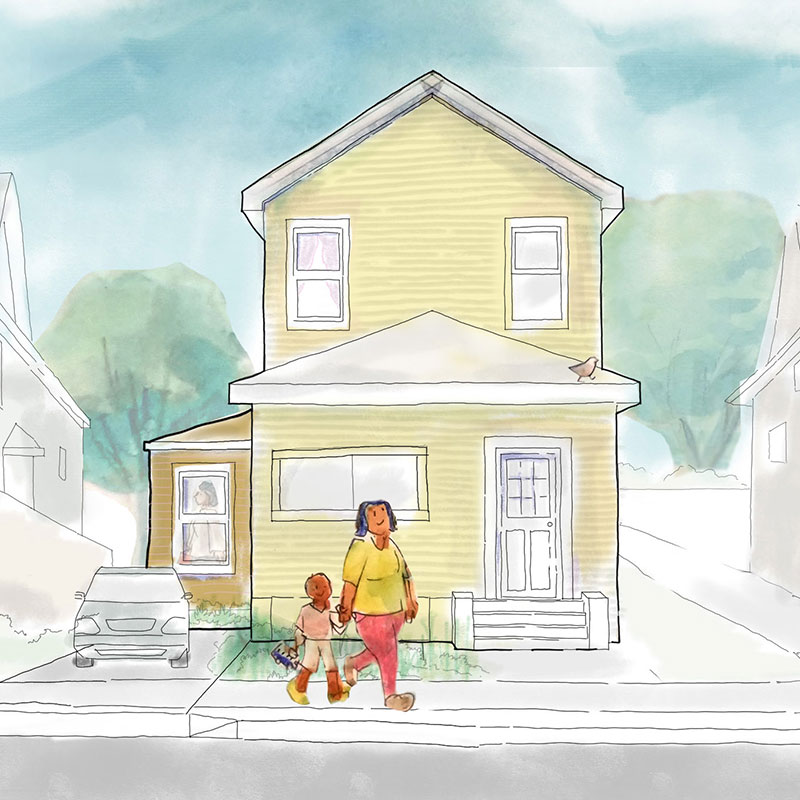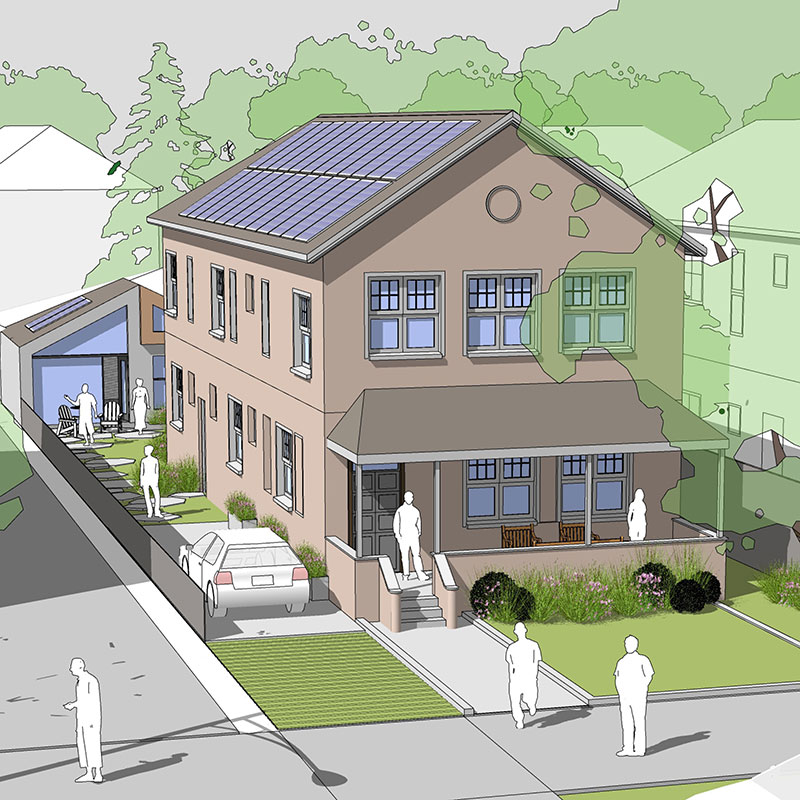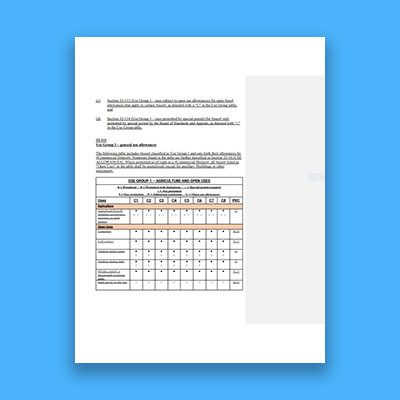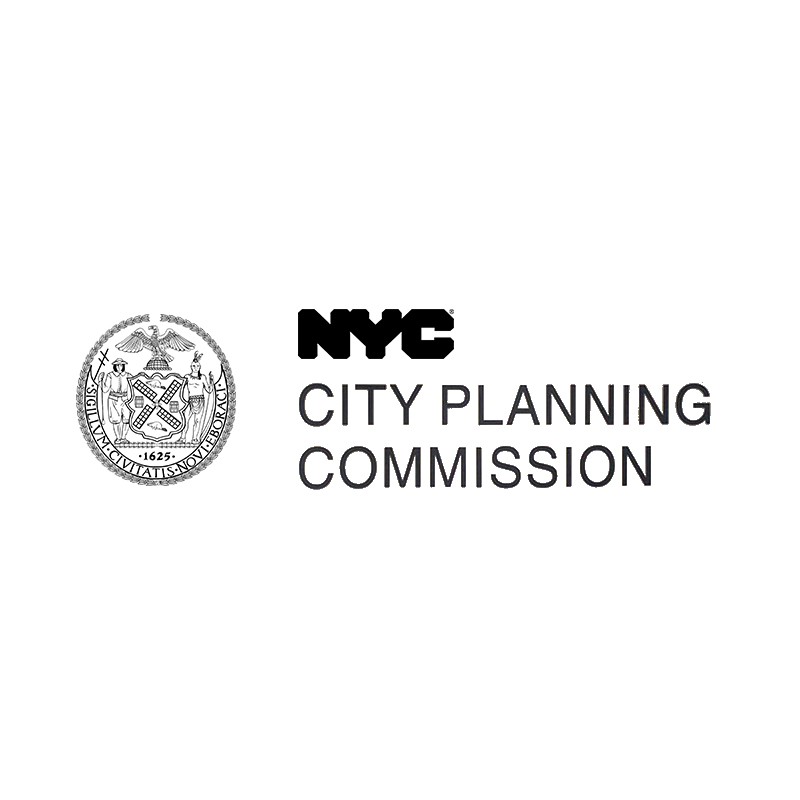
 Department of City Planning311
Department of City Planning311 Search all NYC.gov websites
Search all NYC.gov websites
City of Yes
Housing Opportunity

Every day, New Yorkers struggle with our city’s housing shortage. High housing costs, long commutes, cramped apartments, and instability are all the result of a lack of options. Outdated, restrictive, and complicated zoning laws limit opportunities to create new homes and make those that do get built more expensive.
City of Yes for Housing Opportunity is a zoning reform proposal that would address the housing crisis by making it possible to build a little more housing in every neighborhood. If every neighborhood contributes, we can make a big impact citywide without burdening any one area.
The proposal went through public review in the spring & summer of 2024, with community boards & borough presidents providing input and the City Planning Commission (CPC) holding a public hearing. In September, the CPC approved the proposal. The City Council held a public hearing in October and will vote before the end of the year.
What would City of Yes for Housing Opportunity do?
In recent decades, high-demand neighborhoods have lost affordable housing and become increasingly out of reach to working families.
The Universal Affordability Preference is a new tool that would allow buildings to add at least 20% more housing, if the additional homes are affordable to households earning 60% of the Area Median Income (AMI). As a result, it will deliver new affordable housing in high-cost neighborhoods across New York City to working families.
Today, outdated rules prevent underused offices and other non-residential space from converting to housing. For example, many buildings constructed after 1961, or outside the city's largest office centers, cannot be converted to housing.
City of Yes will make it easier for vacant offices and other non-residential buildings to become homes, a win-win policy to create housing, boost property values, and create more active, vibrant neighborhoods in areas that have been hard-hit by the effects of the pandemic.
New York is a city of neighborhoods, and each neighborhood is anchored by commercial corridors with shops and vibrant street life – a little town center for every community.
Modest apartment buildings with stores on the street and apartments above exist in low-density areas across the five boroughs – most of them from the 1920s to 1950s. Today, zoning prohibits that classic form even in areas where it’s very common.
City of Yes would relegalize buildings with 2, 3 or 4 stories of housing above a commercial ground floor, depending on underlying zoning. These buildings would match their surroundings and provide urgently needed homes.
New York City currently mandates off-street parking along with new housing even where it's not needed, driving down housing production and driving up rents.
City of Yes would lift parking mandates for new housing, as many cities across the country have successfully done. The proposal will preserve the option to add parking, but no one will be forced to build unnecessary parking.
For seniors fighting to stay in the neighborhood on a fixed income, or young people stretching to afford a first home, adding a small unit can be life changing. But under current rules, NYC homeowners can’t choose to use their properties in this way. City of Yes for Housing Opportunity would allow “accessory dwelling units,” or ADUs – which include backyard cottages, garage conversions, and basement apartments.
Many other cities have already legalized accessory dwelling units because they support homeowners, and provide more space for multigenerational families without significantly changing the look and feel of a neighborhood.
Modest apartment buildings already exist in lower-density areas of the five boroughs, most of them built between the 1920s and 1950s. However, current zoning bans new ones despite the severe housing shortage.
City of Yes would re-legalize modestly-sized, transit-oriented apartment buildings in low-density residence districts. Sites must be near transit, over 5,000 square feet, and either on the short end of a block or facing a street 75+ feet wide. Buildings would be 3, 4 or 5 stories, depending on zoning district.
These modest “missing middle” apartment buildings would match the scale and character of existing buildings that can no longer be built.
Across NYC, many campuses, including churches, have underused space that they could turn into housing, if arbitrary zoning rules didn’t get in the way.
If existing buildings are too tall or too far back from the street, for instance, zoning prohibits new developments on the property – even if they would comply with current height limits and other regulations. Where housing is allowed, outdated zoning requires tall and skinny buildings that are out of context with their surroundings.
By removing obstacles and streamlining outdated rules, City of Yes for Housing Opportunity would make it easier to add new contextual, height-limited buildings to campuses. These new buildings could bring money for repairs, new facilities, and housing!
There are many types of campuses, from churches to private residential co-ops, campuses and schools. NYCHA campuses are not included in City of Yes.
City of Yes advances key recommendations from the Where We Live NYC Plan. Where We Live NYC is the outcome of an in-depth two-year process with over 150 community partners that identified strategies for fair housing and equity.
NYC banned shared housing in the 1950s and apartment buildings full of studio apartments in the 1960s. This has contributed to the homelessness crisis in the decades since, and forced people who would prefer to live alone into living with roommates.
City of Yes for Housing Opportunity would re-legalize housing with shared kitchens or other common facilities. It would also allow buildings with more studios and one-bedrooms for the many New Yorkers who want to live alone but don’t have that option today.
These apartments are important for so many people – recent college graduates, older households that are downsizing, and everyone who lives with roommates but would prefer to live alone. Allowing more small and shared apartments will also open up larger, family-sized apartments otherwise be occupied by roommates.
Proposal Guides
View these guides in Spanish and Simplified Chinese.
Topic Specific Guides
Frequently-Asked Questions
Zoning Details
Past Meetings
Watch videos from our monthly info session series focusing on the City of Yes for Housing Opportunity proposals. Select videos from the playlist to the right of the video player.
View presentation slides from these information sessions:
- Pre-Hearing Review Session Presentation
- Missing Middle Housing Types
- Diverse Housing Types
- Universal Affordability Preference Info Session
- City of Yes for Housing Opportunity Overview
Environmental Impact Statement
An environmental impact statement was conducted and a notice of completion for the Final Environmental Impact Statement (FEIS) was issued on September 13, 2024.
- View the sFEIS on the Zoning Application Portal here under Public Documents. See 2023Y0427_FEIS_24DCP033Y_1, 2023Y0427_FEIS_Executive Summary_1” and “2023Y0427_FEIS_Notice of Completion_1”.
What they're saying
Read More
- 10/25/2024 – New York Times: What a Giant Hole Says About a Broad Parking Problem
- 10/21/2024 – New York Times: Why Does This Building by the Subway Need 193 Parking Spots? (Yes, Exactly 193.)
- 9/25/2024 – City Limits: Planning Commission Approves ‘City of Yes’ Housing Plan by 10-3 Vote
- 8/20/2024 – Commercial Observer: A New York City Office-to-Residential Conversion Wave Builds
- 8/6/2024 – City Limits: New Funding for ‘Accessory’ Apartments Touted as Tool for Housing Older New Yorkers
- 7/10/2024 – The City: City of Yes Housing Proposal Picks Up New Support Ahead of Crucial Hearing
- 7/3/2024 – Queens Daily Eagle: Planning commission chair discusses City of Yes’ potential impact on Queens
- 7/2/2024 – Streetsblog: City of Yes: Parking Mandates Have Shaped New York … For Worse
- 6/27/2024 – Gothamist: NYC’s housing shortage costing billions in lost taxes, report finds
- 6/13/2024 – QNS: Department of City Planning director discusses ‘City of Yes’ housing proposal
- 4/29/2024 – Daily News: Adams kicks off “City of Yes” housing plan; next stop: community boards
- 3/26 – Bronx Times: Bronx faith leaders lend support to Faith-Based Affordable Housing Act
- 3/22/2024 – BK Reader: Housing Should Be Built on Land Owned by Churches, Nonprofits, Adams Says
- 3/22/2024 – Harlem World: Mayor Adams Reveals Strategy To Assist Faith-Based Groups In Constructing Affordable Housing In NYC
- 9/21/2023 - New York Times: In Yards, Offices and Basements, New York Hopes to Build 100,000 Homes
- 9/21/2023 - City Limits: Mayor Adams Pitches Zoning For Less Parking, More Housing
- 9/21/2023 - StreetsBlog NYC: City of Yes Yes Yes! Adams Calls for Elimination of Parking Mandates on ALL New Housing
- 10/02/2024 – New York Law School Policy Briefing on City of Yes for Housing Opportunity
- 9/20/2024 – City of Yes for Housing Opportunity: Missing Middle Apartment Buildings
- 8/29/2024 – Manhattan Borough President Mark Levine on Shared Housing in City of Yes for Housing Opportunity
- 8/14/2024 – Council Member Keith Powers on his support for City of Yes for Housing Opportunity
- 7/17/2024 – Rhythm and Soul Radio: Mayor Adams on City of Yes for Housing Opportunity
- 7/12/2024 – New York 1: Planning Commission holds public hearing on city’s zoning proposal to build more housing
- 7/1/2024 – Manhattan Borough President Mark Levine on City of Yes for Housing Opportunity
- 6/11/2024 – Questions and Misconceptions: City of Yes for Housing Opportunity
- 5/28/2024 – NY1: Brooklyn borough president discusses ‘City of Yes’
- 4/29/2024 – News12: City of Yes for Housing Opportunity hosted by Mayor Adams at City Hall
- 4/29/2024 – NY1: Mayor’s housing plan officially enters public review process
- 9/21/2023 - NY1: Adams announces bold proposal to tackle housing crisis
- 9/22/2023 - Fox 5 New York: 100,000 new homes in NYC?
- 9/21/2023 - NY1: Adams announces bold proposal to tackle housing crisis
- 11/10/2024 – Daily News: Housing yes, parking no: Do not prioritize cars over people
- 11/10/2024 – Crain’s: Election results show leaders must tackle city affordability
- 11/02/2024 – Daily News: Two prongs: Council and City Hall housing plans are not in conflict
- 10/23/2024 – Daily News: Getting to Yes: The City Council should listen to New Yorkers who back zoning plan to boost housing
- 10/21/2024 – Daily News: The City Council is making history: Pass City of Yes zoning change to expand housing
- 9/25/2024 – Daily News: Say yes to more housing: City Planning Commission must vote in favor today
- 9/2/2024 – Daily News: An old way of living is now new: SROs must be part of NYC’s push for more housing
- 8/26/2024 – Daily News: Build for America: The whole country needs more housing
- 8/9/2024 – What’s the [DATA] Point? 109,000 with Dan Garodnick
- 7/12/2024 – Daily News: Say yes to the Yes: NYC needs housing, and City of Yes can deliver
- 7/1/2024 – Crain’s: Every neighborhood must do its part to create more housing
- 4/14/2024 – Daily News: A home for us: Mayor Adams’ housing plan is a good foundation for NYC
- 11/22/2023 - Daily News: Build for the future: N.Y. needs lots more housing
- 11/6/2023 - Crain’s NY: The city has a chance to correct a mindset from the 1960s to create more housing
- 10/26/2023 - Bloomberg: How to Solve New York City’s Housing Crisis
- 9/24/2023 - Daily News: Eric Adams’ housing plan is what NYC needs
- 10/22/2024 – Jennifer March in City Limits: For Our Children, Say ‘Yes’ to Housing
- 10/18/2024 - Manny Pastreich in AM New York: Everyday New Yorkers must step up and say ‘yes’ to City of Yes
- 10/13/2024 - Erik Bottcher and Jennifer Gutierrez in AM New York: Eliminating ‘parking minimums’ in NYC can help ease the housing crisis
- 10/10/2024 – Kirk Goodrich in AM New York: Removing parking mandates is a plausible trade off to increase affordable housing
- 10/03/2024 – Queens resident Lindsey McCormack in Queens Chronicle: City of Yes a happy medium
- 9/29/2024 – NYC Dept. for the Aging Commissioner Lorraine Cortés-Vázquez and AARP New York State Director Beth Finkel in AM New York: AARP is for ADU’s in Mayor’s City of Yes
- 9/25/2024 – Met Council on Jewish Poverty CEO David Greenfield in Daily News: Add homes for NYers who need them most
- 9/22/2024 – New York League of Conservation Voters: Say Yes to the City of Yes: Zoning Reform Is Also a Climate Win
- 9/18/2024 – JASA CEO Kathryn Haslanger in City Limits: City of Yes Will Help Turn Underutilized Space into Life-Saving Housing
- 9/17/2024 – Dept. of City Planning Director Dan Garodnick in Queens Daily Eagle: Clearing the air on City of Yes
- 9/12/2024 – Personal attorney and speechwriter to Dr. Martin Luther King Jr., Clarence Jones, in Daily News: Make real Dr. King’s housing equity dream
- 8/29/2024 – Chhaya Executive Director Annetta Seecharran in Queens Chronicle: Legalize ADUs to help our neighbors in their homes
- 8/22/2024 – NYC Dept. of City Planning Director Dan Garodnick, Dept. of Housing Preservation and Development Adolfo Carrion Jr., Dept. of Social Services Molly Wasow Park, and NYCHA CEO Lisa Bova-Hiatt in Daily News: We are adding more housing for all New Yorkers
- 8/22/2024 – Queens resident Bill Bruno in Queens Chronicle: Yes to CoY Housing
- 8/16/2024 – Queens homeowner Sade Singh in Queens Daily Eagle: Supporting accessory homes will help homeowners like me
- 8/13/2024 – New York City Deputy Mayor Maria Torres-Springer in Daily News: Building out to fix NYC’s problems
- 8/8/2024 – Fifth Avenue Committee Executive Director Michelle de la Uz in Brooklyn Paper: Brooklyn must say ‘Yes to Housing’
- 8/7/2024 – Breaking Ground President and CEO Brenda Rosen in Bronx Times: The Bronx needs fair housing and City of Yes can help
- 7/31/2024 – Community Preservation Corporation CEO Rafael E. Cestero in AM New York: Embracing the City of Yes for Housing Opportunity
- 7/15/2024 – Mayor Eric Adams in Harlem World Magazine: City Of Yes, A Little More Housing In Every Neighborhood
- 7/10/2024 – New Destiny Housing Director of Policy and Communication Gabriela Sandoval Requena in AM New York: Queens can be a home for everyone
- 6/28/2024 – AARP New York State Director Beth Finkel in Daily News: Creating homes for older New Yorkers
- 6/27/2024 – Old Astoria Neighborhood Association President Richard Khuzami in QNS: The benefits of the City of Yes Housing proposal
- 6/11/2024 – New York State Association for Affordable Housing President and CEO Jolie Milstein in Commercial Observer: ‘City of Yes for Housing Opportunity’ — Let’s Answer the Call
- 4/24/2024 – Partnership for New York City President and CEO Kathryn Wylde in Crain’s: City of Yes: A first step toward a more affordable New York
- 3/25/2024 – Mayor Eric Adams in Caribbean Life: Yes to housing in God’s backyard
- 3/6/2024 – Municipal Art Society of New York in Crain’s: City of Yes housing plan is refreshingly holistic
- 2/15/2024 - Mayor Eric Adams and City Council Speaker Adrienne Adams in the Daily News: Fixes for NYC housing shortage
- 1/5/2024 - Slate Property Group and Open Plans in Crain’s: To build more housing, build less parking
- 10/2/2023 - Mayor Eric Adams in amNY: The future of housing in NYC
Contact Us
For more information or to ask questions, please contact: HousingOpportunity@planning.nyc.gov.
Subscribe for City of Yes updates
Go to City of Yes:


























